Some Quick Gaming Numbers at 4K, Max Settings
by Ian Cutress on July 1, 2013 8:00 AM ESTPart of my extra-curricular testing post Computex this year put me in the hands of a Sharp 4K30 monitor for three days and with a variety of AMD and NVIDIA GPUs on an overclocked Haswell system. With my test-bed SSD at hand and limited time, I was able to test my normal motherboard gaming benchmark suite at this crazy resolution (3840x2160) for several GPU combinations. Many thanks to GIGABYTE for this brief but eye-opening opportunity.
The test setup is as follows:
Intel Core i7-4770K @ 4.2 GHz, High Performance Mode
Corsair Vengeance Pro 2x8GB DDR3-2800 11-14-14
GIGABYTE Z87X-OC Force (PLX 8747 enabled)
2x GIGABYTE 1200W PSU
Windows 7 64-bit SP1
Drivers: GeForce 320.18 WHQL / Catalyst 13.6 Beta
GPUs:
| NVIDIA | ||||||
|---|---|---|---|---|---|---|
| GPU | Model | Cores / SPs | MHz | Memory Size | MHz | Memory Bus |
| GTX Titan | GV-NTITAN-6GD-B | 2688 | 837 | 6 GB | 1500 | 384-bit |
| GTX 690 | GV-N690D5-4GD-B | 2x1536 | 915 | 2 x 2GB | 1500 | 2x256-bit |
| GTX 680 | GV-N680D5-2GD-B | 1536 | 1006 | 2 GB | 1500 | 256-bit |
| GTX 660 Ti | GV-N66TOC-2GD | 1344 | 1032 | 2 GB | 1500 | 192-bit |
| AMD | ||||||
| GPU | Model | Cores / SPs | MHz | Memory Size | MHz | Memory Bus |
| HD 7990 | GV-R799D5-6GD-B | 2x2048 | 950 | 2 x 3GB | 1500 | 2x384-bit |
| HD 7950 | GV-R795WF3-3GD | 1792 | 900 | 3GB | 1250 | 384-bit |
| HD 7790 | GV-R779OC-2GD | 896 | 1075 | 2GB | 1500 | 128-bit |
For some of these GPUs we had several of the same model at hand to test. As a result, we tested from one GTX Titan to four, 1x GTX 690, 1x and 2x GTX 680, 1x 660Ti, 1x 7990, 1x and 3x 7950, and 1x 7790. There were several more groups of GPUs available, but alas we did not have time. Also for the time being we are not doing any GPU analysis on many multi-AMD setups, which we know can have issues – as I have not got to grips with FCAT personally I thought it would be more beneficial to run numbers over learning new testing procedures.
Games:
As I only had my motherboard gaming tests available and little time to download fresh ones (you would be surprised at how slow in general Taiwan internet can be, especially during working hours), we have a standard array of Metro 2033, Dirt 3 and Sleeping Dogs. Each one was run at 3840x2160 and maximum settings in our standard Gaming CPU procedures (maximum settings as the benchmark GUI allows).
Metro 2033, Max Settings, 3840x2160:
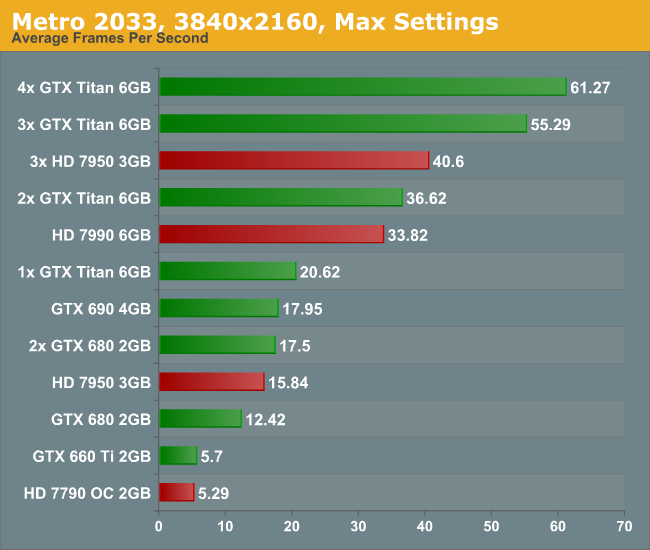
Straight off the bat is a bit of a shocker – to get 60 FPS we need FOUR Titans. Three 7950s performed at 40 FPS, though there was plenty of microstutter visible during the run. For both the low end cards, the 7790 and 660 Ti, the full quality textures did not seem to load properly.
Dirt 3, Max Settings, 3840x2160:
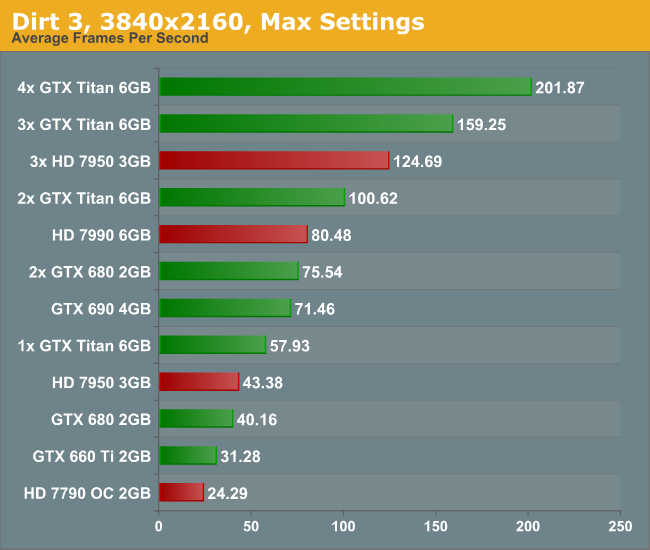
Dirt is a title that loves MHz and GPU power, and due to the engine is quite happy to run around 60 FPS on a single Titan. Understandably this means that for almost every other card you need at least two GPUs to hit this number, more so if you have the opportunity to run 4K in 3D.
Sleeping Dogs, Max Settings, 3840x2160:
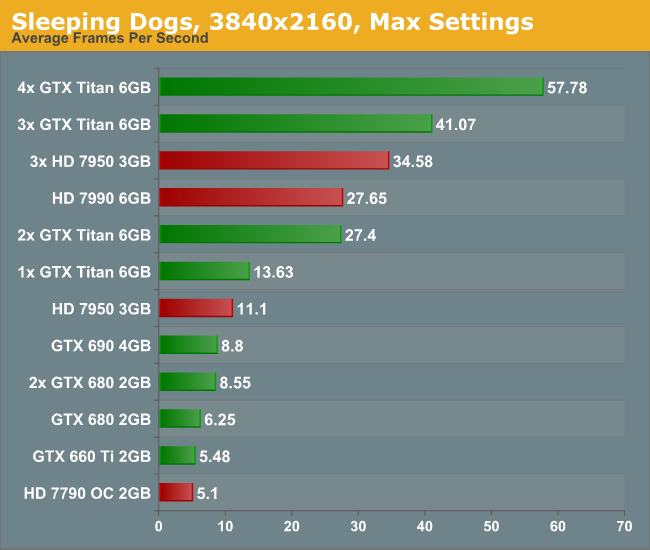
Similarly to Metro, Sleeping Dogs (with full SSAA) can bring graphics cards down to their knees. Interestingly during the benchmark some of the scenes that ran well were counterbalanced by the indoor manor scene which could run slower than 2 FPS on the more mid-range cards. In order to feel a full 60 FPS average with max SSAA, we are looking at a quad-SLI setup with GTX Titans.
Conclusion:
First of all, the minute you experience 4K with appropriate content it is worth a long double take. With a native 4K screen and a decent frame rate, it looks stunning. Although you have to sit further back to take it all in, it is fun to get up close and see just how good the image can be. The only downside with my testing (apart from some of the low frame rates) is when the realisation that you are at 30 Hz kicks in. The visual tearing of Dirt3 during high speed parts was hard to miss.
But the newer the game, and the more elaborate you wish to be with the advanced settings, then 4K is going to require horsepower and plenty of it. Once 4K monitors hit a nice price point for 60 Hz panels (sub $1500), the gamers that like to splash out on their graphics cards will start jumping on the 4K screens. I mention 60 Hz because the 30 Hz panel we were able to test on looked fairly poor in the high FPS Dirt3 scenarios, with clear tearing on the ground as the car raced through the scene. Currently users in North America can get the Seiki 50” 4K30 monitor for around $1500, and they recently announced a 39” 4K30 monitor for around $700. ASUS are releasing their 4K60 31.5” monitor later this year for around $3800 which might bring about the start of the resolution revolution, at least for the high-end prosumer space.
All I want to predict at this point is that driving screen resolutions up will have to cause a sharp increase in graphics card performance, as well as multi-card driver compatibility. No matter the resolution, enthusiasts will want to run their games with all the eye candy, even if it takes three or four GTX Titans to get there. For the rest of us right now on our one or two mid-to-high end GPUs, we might have to wait 2-3 years for the prices of the monitors to come down and the power of mid-range GPUs to go up. These are exciting times, and we have not even touched what might happen in multiplayer. The next question is the console placement – gaming at 4K would be severely restrictive when using the equivalent of a single 7850 on a Jaguar core, even if it does have a high memory bandwidth. Roll on Playstation 5 and Xbox Two (Four?), when 4K TVs in the home might actually be a thing by 2023.
16:9 4K Comparison image from Wikipedia


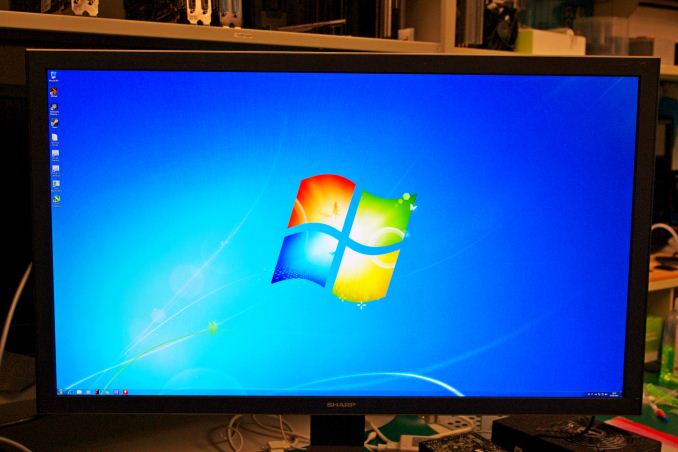

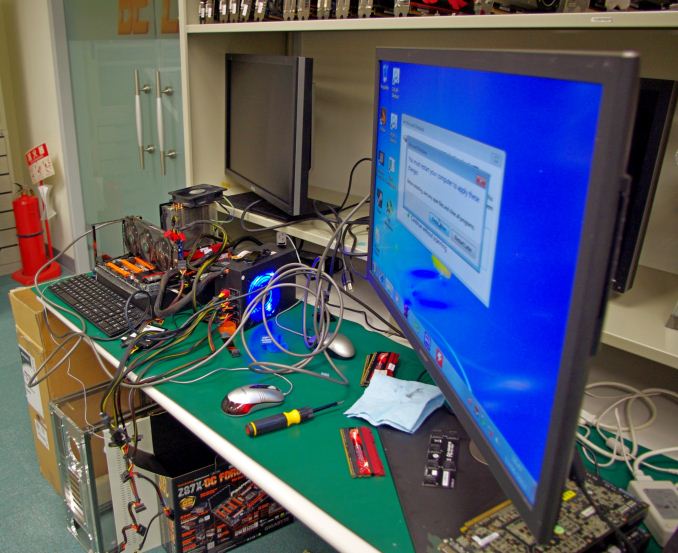

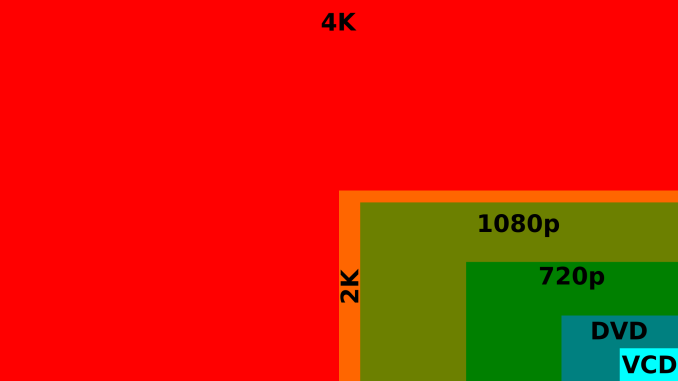








134 Comments
View All Comments
kyuu - Tuesday, July 2, 2013 - link
Well let's see:1) The Oculus Rift makes no sense for games that are not FPV. Personally, there's only one FPV game coming out in the future that I'm interested in.
2) Currently, there are only a very few games that support the Rift and none of them are being used for benchmarking. Even if they were, no one has a final release Rift because they aren't out yet.
3) Running the Rift should be identical to running a 3D 1080p monitor as far as graphics performance is concerned, so there isn't a real need to specifically benchmark the Rift.
4) Lots of people care more about higher resolutions than the Rift because, again, the Rift only makes sense for FPV games.
testbug00 - Monday, July 1, 2013 - link
Why no 7970 6GB?Gigabyte does not have those 0.0?
NOTE: is it possible to disable one of the GPU on dual-GPU boards? I would guess not, but it would be cool if you could :)
jadedcorliss - Monday, July 1, 2013 - link
Pure insanity. I feel that gaming at 1920x1080p or 2560x1440p should be something of a norm for the foreseeable future. I probably won't be able to be bothered to even think about gaming beyond that, and I'm not much of a 3D gaming or multiple monitor gaming fan.hfm - Monday, July 1, 2013 - link
Metro 2033.. or the year a single GPU will be able to do this...JeBarr - Monday, July 1, 2013 - link
I hope not. If I have to wait that long for a single GPU to run UHD at 30Hz then let's just stop and throw in the towel right now before any moar time and money is wasted.JlHADJOE - Monday, July 1, 2013 - link
3x 7950s beating 2x Titans makes AMD look like pretty awesome value.titanmiller - Monday, July 1, 2013 - link
It's a shame that the next gen consoles are coming into the world at the same time as 4K. This means that consumers will have to wait...5-10 years before they can buy a console with enough power to run 4K games.Impulses - Tuesday, July 2, 2013 - link
Timing's not that bad really, it'll probably take about that long for these newer displays to come down in price and become the norm... I doubt pushing a 4k-capable console in two year's time would really accelerate that process, but I'm not really into consoles these days so maybe I'm underestimating their impact. Hopefully PC GPUs move at a much faster pace, am I the only one that's thinking multiple 4k displays would make a badass setup? :p C'mon now, there's already a lot of people running 3x1440... I'd be one if I had an unlimited budget and space, 3x1200 will have to do for now!Seegs108 - Monday, July 1, 2013 - link
I think it's important to note the various typos in this article. This is not 4K resolution, this is UHD resolution. For an analogy, this is like calling 1080p '2K'. 4K is 4096 x 2160. UHD is 3840 x 2160. I find it annoying this is still an issue people keep making.Gigaplex - Tuesday, July 2, 2013 - link
Even though it's not correct terminology, the fault does not lie with this article. The entire industry is getting it wrong, and these UHD displays are being marketed as 4K.